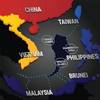“Intra-Mediterranean Container Trades” Update
Dynamar has published “INTRA-MEDITERRANEAN CONTAINER TRADES”, the latest report in its Container Trades and Markets series. Salient details and interesting findings of the new report are discussed here below.
Intra-Mediterranean (2014) Container Trades is all about the 170 services operated by 40 different shipping companies deploying 275 container, Ro/Ro and multipurpose ships with container capacities of 400 to 3,000 TEU that populate the intra and coastal all Mediterranean waters. Through nearly 100 ports in 24 countries, they serve some 700 million people in frequencies of between twice and many times per month, carrying an average of 275,000 full TEU of regional trade and feeder boxes every week.
Dynamar forecasts the 2015 volume of the total Intra-Mediterranean full container trade (regional trade and feeder boxes) to reach 15.6 million TEU, up from 14.9 million TEU in 2013, and growing to 17.1 million TEU by 2017.
Introduction
The third edition of this unique report literally dissects the intra-Mediterranean container trade as it daily unfolds between the two outlets of Gibraltar Straits and the Suez Canal. It provides an assessment of the overall trade with respect to its size in terms of volumes, capacities and throughputs, as well as an in-depth competition review (companies, services, ships, capacity analyses, liftings).
In terms of connectivity, the Aegean sub trade is the numero uno with 275 trade connections; the Black Sea is at the bottom of this ranking with just 71. With respect to individual port connectivity, Piraeus is at the top with 54 connections, but Alexandria is on its heels: 53.
Services and ports
The roundabout 170 intra-Mediterranean shipping services carrying containers call at total 100 ports large and small spread all over mare nostrum. Combined, these services offer nearly (and incidentally) 170 sailings per week, an average of 90 departures every day from each port. Variations in this sailing frequency are substantial, ranging between twice a month at Famagusta to nearly 54 per week at Piraeus and Alexandria.
Dominant transhipment ports are those whose transhipment volumes make up for more than 50% of their total throughput. There are ten of them in the Mediterranean. With 95% each, Gioia Tauro and Tangier-Med Port had the highest shares. In 2013, Algeciras handled the largest transhipment volume: nearly 4.0 million TEU, ahead of Port Said’s 3.8 million TEU.
With a transhipment volume of nearly 4.0 million TEU in 2013, Algeciras is the largest Mediterranean hub, ahead of Port Said with 3.8 million TEU.
Eight Global Terminal Operators are involved in total thirty Mediterranean box facilities, also handling intra-trade. With eight terminals, including projects, APM Terminals is the largest in this respect, followed by DP World (6) and MSC-subsidiary TIL (5).
Main and Sub Trade Areas
The intra-Mediterranean trade comprises two main areas: West Mediterranean and East Mediterranean. The West Med again is broken down into two sub trade areas: West (Europe) Med and Maghreb (North Africa), while the East Med encompasses the Adriatic, Aegean (Greece & Turkey), Black Sea and Levant (Turkey East Med through to Egypt) sub trades. The number of services and their annual capacity operating to, from, between and within each of those sub-trade areas varies greatly.
In line with this, also the throughputs of the around 70 intra-Mediterranean ports for which this is known differ substantially: between just 360 TEU at Monfalcone (Italy, Adriatic) and 4.4 million TEU (Algeciras, Spain). It is a relatively high average of 735,000 TEU for all ports. On a country basis, Spain handles the largest number of containers (import and export, full and empty, including transhipment): more than 11 million TEU in 2013. Croatia is the smallest country in this respect with just 132,000 TEU.
The total 2013 global throughput of 95 ports handling intra-Mediterranean container trade can be estimated at 56 million TEU. This constitutes a growth of some 5.5% over 2012.
West (Europe) Med
Intra-Mediterranean services calling at ports in the four countries -Spain, France, Italy and Malta- forming the West (Europe) Med trade area provide an annual capacity of nearly 2.7 million TEU. They connect this area with all other sub trade areas. This will not come as a surprise, considering the large inter-regional ports of Valencia, Barcelona, Marseilles and Genoa, and the major transhipment hubs of Algeciras, Tangier-Med, Malta and Gioia Tauro in this part of the Med. They handle the bulk of gateway cargo here, as well as most of the transhipment containers destined for feeder ports across the West and East Mediterranean.
Intra-Mediterranean shipping services calling ports in the European sector of the West Mediterranean provide an annual trade capacity of 2.7 million TEU.
Adriatic
At almost the other end of the line in terms of overall maritime container traffic capacity is the Adriatic, comprising trade from and to ports at the east coast of Italy, and in Slovenia, Croatia, Montenegro and Albania. The annualised trade capacity of the services calling there, connecting with outlets in all other East and West Med trades areas is 860,000 TEU. Therewith it is the second smallest of the intra-Mediterranean trade areas.
The Adriatic, currently one of the smallest trade areas, is considered to offer a large potential for growth of intra-Mediterranean shipping volumes.
Aegean
It will not come as a surprise that the Aegean, comprising the waters between Greece and Turkey, is the second largest intra-Mediterranean trade area, providing a capacity of 2.45 million TEU. Its total population counts 86 million. Next to abundantly growing Piraeus in Greece, main ports here are primarily located around the Sea of Marmara (no less than 17 different terminals handling boxes) and in the Izmir area (including Nemruth Bay). The Marmara main port complex of Ambarli will soon be confronted with competition from a new, very large, MSC-controlled transhipment port in the form of (ultimately) 2.5 million TEU earthquake-resistant Asyaport.
In terms of intra-Mediterranean connectivity, the Aegean sub-trade area is the numero uno with 275 trade connections (i.e. number of sailings per week). The Black Sea is at the bottom of this ranking with just 71.
Black Sea
The north-easternmost part of the Mediterranean is the Black Sea, accessible via the Bosporus, which has a maximum vessel length restriction of 300 metres. This is becoming a tight margin for the deepsea mainline vessel services steaming into the Black Sea directly from their overseas origins. These operations connect with North Europe (1 service), the Far East (3), Indian Sub Continent (1) and Latin America (1). Length is no problem at all for the average intra-Mediterranean regional cargo and feeder ship, together providing a capacity of 853,000 TEU connecting with five of the six intra-Med trades. The Magreb countries (Libya, Tunisia, Algeria and Morocco) are not on Black Sea schedules.
The Bosporus, connecting the East Mediterranean with the Black Sea and flowing through Istanbul city-centre, has a maximum vessel length restriction of 300 metres. The largest ship passing through this natural waterway is a 9,400 TEU CMA CGM newbuilding with a length-over-all of 299.95 metres.
Levant
Despite the awkward situation in some of the countries forming the Levant, with nearly 2.3 million capacity Turkey/East Med, Cyprus, Syria, Lebanon, Israel and Egypt still form the third largest intra-Mediterranean sub-trade area. It is connected with all other sub-trade regions. This is not in the last place due to Egypt with its major transhipment centre of Port Said (4.1 million TEU), gateway Alexandria (1.5 million TEU) and hybrid Damietta, together accounting for 6.3 million TEU as a country.
Israel (2,539,000 TEU) and Lebanon (1,117,000 TEU) are both among the Mediterranean throughput country millionaires.
Maghreb
The West (Europe) Med region is the main trade area connected with the four North African Maghreb countries. These comprise Libya, Tunisia, Algeria and Morocco. With respect to the latter, only the port of Tangier-Med is concerned, i.e. Morocco’s west coast ports of Casablanca and Agadir, both outside the Med indeed, have not been considered. North African ports do not connect to the Black Sea, while their just 4,000 TEU trade relation with the Adriatic is small. However, almost equal to another, the Aegean (2.45 million TEU) and the Levant (2.25 million TEU) are large Maghreb partners. After Morocco’s Tangier-Med Port (nearly 2.6 million TEU), Algeria’s capital Algiers is the second largest North African port with a 2013 throughput of 737,000 TEU.
With 34 calls per week at eight of its ports, Algeria is the largest Maghreb country in terms of connectivity with other Mediterranean countries.
Carriers and ships
As it should be, the vast majority of the intra-Mediterranean carriers, 28 out of total 40, originate from the region itself. MSC (Mediterranean Shipping Company) is the undisputed leader with an overall capacity share of 25%. Marseilles-based CMA CGM comes second with 15%, while fast growing Izmir/Turkey-headquartered Arkas Line is 3rd, operating 15% of all intra-Med capacity. A further “local” carrier known beyond the Mediterranean is ZIM (2%), which is followed by a raft of others from the region with shares of 1% or less.
Combined, the Top 5 carriers, to which furthermore belong the two Danish companies Maersk Line and Unifeeder, account for 60% of the ships and 68% of capacity. Mathematically, the intra-Mediterranean trade exactly follows the Pareto* principle, also known as the 80–20 rule, the law of the vital few. The eight largest, 20% of all 40 carriers, operate 80% of annualised trade capacity. * Vilfredo Pareto was an Italian economist.
Average intra-Med vessel capacity is 1,200 TEU. Those operating on Maghreb routes are the smallest: 800 TEU; to and from Levant ports the average ship size is 1,400 TEU. Hapag-Lloyd deploys the largest ship currently piercing the intra-Mediterranean waves: the 3,600 TEU “Norfolk Express”, operating on the Port Said-Black Sea route. The smallest cellular container vessel is trading between Sea of Marmara and other Turkish ports and Piraeus: the Marti Shipping-operated 450 TEU “Marti Prosperity”.
MSC’s East Med/Black Sea service is the longest intra-Mediterranean route by nautical miles of all 40 carriers in Dynamar’s Intra-Mediterranean study. Notwithstanding the operation’s name, it connects four of the six sub trade areas. When its five 2,700 TEU ships to Gioia Tauro (Southern Italy), where they started their weekly trip along Piraeus, Gemlik, Istanbul (Gebze), Istanbul (Ambarli), Novorossisk, Constantza, Trieste, Venice, Ravenna and Koper they have travelled a distance of nearly 4,900 nautical miles. This is equal to a trip from Algeciras at the Atlantic entrance of the Med to Mumbai, India.
The profiles on all 40 intra-Mediterranean carriers in the report provide company details and background, overall and specific intra-Med fleet size and capacity, including by sub trade.
MSC is the largest intra-Mediterranean carrier by annualised one-way capacity (1.5 million TEU), ahead of CMA CGM (900,000 TEU). It also operates the longest intra-Med service, connecting four trade areas during a 4,900 nautical miles roundtrip.
Issued in mid-October, the Intra-Mediterranean Container Trades uses the most recent statistics on port/country carryings, vessel capacities and port throughputs, and gives a profound insight into the intra-Mediterranean regional and feeder trades, background, characteristics, goings and present status. The 220-page report is provided with over 175 tables and 30 figures.
A study on the intra-Mediterranean subject so comprehensive has never been published before!
Features of Intra-Mediterranean (2014) Container Trades include:
EXECUTIVE SUMMARY
INTRODUCTION
Defining the trade: the Mediterranean, its main basins and sub-trade areas
Shortsea Shipping within the Mediterranean: trading context, developments
CONTAINER LINER CARRIERS
40 trade-related intra-Mediterranean carrier profiles, providing
Providing company details and background, fleet size and capacity,
intra-Mediterranean overall capacity and related data
3-year carrier/trade developments
CONTAINER SHIPPING SERVICES
Major 2011/2014 Service and Market Developments
Services by sub trade: carriers, ships, capacity, connections
Breakbulk and other shipping services
CARRYINGS (Full Container Volumes)
Full container (TEU) 2011-2013 statistics of the intra-Mediterranean trade
By individual Mediterranean sub trade, port and country
Estimated volumes 2014; Forecasts through to 2017
PORTS OF CALL
Ports called in all trade areas, selected particulars, port-handled TEU
Trade capacity shares per port
Transhipment shares Mediterranean hubs
PORTS AND TERMINALS
Latest developments selected ports
Global Terminals Operators and other Majors active in the Mediterranean
INTRA-MEDITERRANEAN TRADE BACKGROUND
Economic and trading contexts
Merchandise trading relationship within the Mediterranean by value and in tons
Country economic and trade profiles; main moving commodities; connectivity indexes
Analyses in the report are based on services and fleet details as of the third quarter of 2014. By definition, shortsea operations, the feedering segment in particular, fluctuate strongly with the markets they serve, which comprise both Mediterranean regional business and the worldwide trades (feedering). Hence, vessel sizes and numbers, and the related capacities fluctuate regularly, albeit without actually affecting the competition picture.










